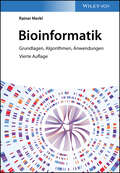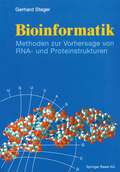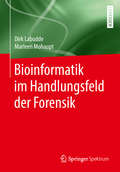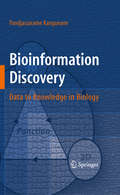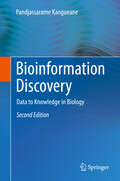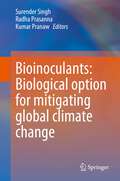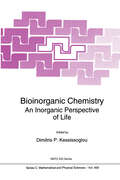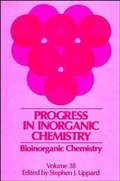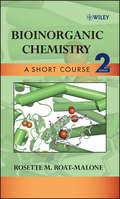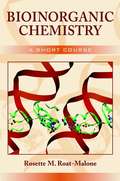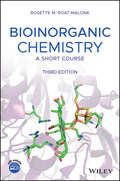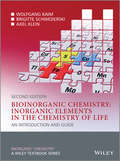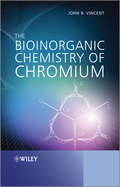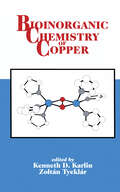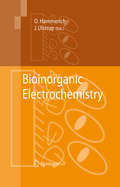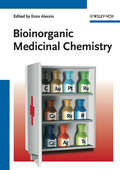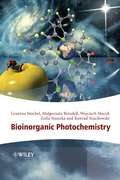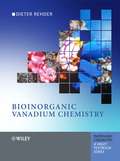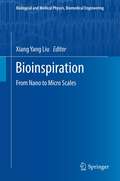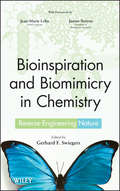- Table View
- List View
Bioinformatik: Grundlagen, Algorithmen, Anwendungen
by Rainer MerklBioinformatik Der Marktführer bei den Bioinformatiklehrbüchern in neuer Auflage und mit dem neuen Thema Molekulardynamik Bioinformatik ist eine Kerndisziplin in den modernen Biowssenschaften, von der Biotechnologie über die Biochemie und Molekularbiologie bis zur Molekulargenetik und Molekularmedizin. Sie ist eine essenzielle Grundlage für alle “omics”-Technologien, für die Strukturbiologie, die Systembiologie sowie die synthetische Biologie. Bioinformatik. Grundlagen, Algorithmen, Anwendungen bietet eine umfassende Einführung in die wichtigsten Methoden der Bioinformatik. Der Autor erklärt dabei sowohl die mathematischen und biologischen Grundlagen als auch die wichtigsten Software-Tools und deren Anwendungsbereiche. Schwerpunkte sind Methoden zum Sequenzvergleich, Verfahren zur Charakterisierung von Proteinfamilien, Algorithmen zur Vorhersage von Protein- und RNA-Strukturen, Methoden des maschinellen Lernens und das Proteindesign. Für die 4. Auflage wurde der Text durchgehend aktualisiert und um ein Kapitel zur Molekulardynamik erweitert. Neu aufgenommene Exkurse zu Meilensteinen der Bioinformatik und aktuellen Anwendungsgebieten lockern den Text auf. Auf der ebenfalls komplett überarbeiteten Begleit-Webseite werden interaktive Lernmodule bereitgestellt, einschließlich mehr als 120 Übungsaufgaben, zum Teil mit Lösungen. Eine perfekte Einführung für alle Studenten der Lebenswissenschaften oder Informatik, die einen Einblick in die gängigen Methoden der Bioinformatik benötigen, sowie ein wertvoller Begleiter für alle, die bereits bioinformatische Werkzeuge nutzen und die zugrundeliegenden Konzepte verstehen möchten.
Bioinformatik: Methoden zur Vorhersage von RNA- und Proteinstrukturen
by Gerhard StegerMit Hilfe der Bioinformatik können ermittelte DNA-, RNA- oder Aminosäuresequenzen hinsichtlich Struktur und Funktion schnell eingeschätzt werden; das spart Kosten und Zeit bei weiterführenden Experimenten im Labor. Das vorliegende Buch gliedert sich in einen RNA- und einen Protein-Teil. Je ein Kapitel führt das biologische Thema der Strukturvorhersage inklusive biophysikalischer Grundlagen der Vorhersagemethoden ein. Folgekapitel gehen auf die informationstechnischen Methoden mit einem möglichst kurzen Beispiel ein, stellen den meist komplizierteren Algorithmus zur Lösung des biologischen Problems vor und diskutieren zum Abschluss mindestens eine Implementation und damit erzielbare Ergebnisse anhand eines biologischen Beispiels. Das Buch ist gleichermassen für Biologen und Informatiker relevant, da es sowohl einen Überblick über die aktuellen Möglichkeiten der Strukturvorhersage gibt als auch den Einsatz von unterschiedlichsten informationstechnischen Methoden in der Biologie demonstriert.
Bioinformatik im Handlungsfeld der Forensik
by Dirk Labudde Marleen MohauptDieses Lehrbuch soll Studierenden den Einstieg in die Gebiete der Forensik und Bioinformatik gleichermaßen erleichtern. Anhand eines fiktiven Falls, der sich durch das gesamte Buch zieht, wird die Bioinformatik und deren Grundlagen in das Gebiet der Forensik übertragen. Der Fall deckt eine Vielzahl an biologischen Spuren, sowie deren klassische Analyse ab und definiert neue Handlungsfelder in der Bioinformatik und Forensik.In diesem Werk werden verschiedenste Bereiche der Forensik bioinformatisch aufbereitet: Genetischer Fingerabdruck: Auswertung auf Sequenz- statt auf Profilebene Fingerspuren: krankheitsbedingte bzw. genetisch bedingte VeränderungenUntersuchungen zum Phänotyp einer PersonGrundlegende Erkenntnisse zur Wundheilung sowie zur Blutalterung in- und ex-vivo Dieses Buch zeigt die Notwendigkeit auf, die Forensik um weitere Wissensbereiche zu ergänzen und gibt Einblicke in eine Vielzahl moderner Themen der Forensik wie zum Beispiel Populationsgenetik; Wundaltersbestimmung, Daktyloskopie oder Menschen ohne Fingerabdruck.Vor allem Studierende aus den Lebenswissenschaften sowie Dozierende ebendieser Fachrichtung, werden durch dieses Lehrbuch spannende Einblicke in topaktuelle Fragestellungen bekommen.
Bioinformation Discovery: Data to Knowledge in Biology
by Pandjassarame KangueaneBioinformation Discovery illustrates the power of biological data in knowledge discovery. It describes biological data types and representations with examples for creating a workflow in Bioinformation discovery. The concepts in knowledge discovery from data are illustrated using line diagrams. The principles and concepts in knowledge discovery are used for the development of prediction models for simulations of biological reactions and events. Advanced topics in molecular evolution and cellular & molecular biology are addressed using Bioinformation gleaned through discovery. Each chapter contains approximately 10 exercises for practice. This will help students to expand their problem solving skills in Bioinformation Discovery. Each chapter concludes with a number of good problem sets to test mastery of the material.
Bioinformation Discovery: Data to Knowledge in Biology
by Pandjassarame KangueaneThis new edition continues to illustrate the power of biological data in knowledge discovery. It describes biological data types and representations with examples for creating a workflow in bioinformation discovery. The concepts in knowledge discovery from data are illustrated using line diagrams. The principles and concepts in knowledge discovery are used for the development of prediction models for simulations of biological reactions and events. Advanced topics in molecular evolution and cellular & molecular biology are addressed using bioinformation gleaned through discovery. Each chapter contains approximately 10 exercises for practice. This will help students to expand their problem solving skills in Bioinformation Discovery. In this new edition, there are three new chapters covering single nucleotide polymorphism, genes, proteins and disease, and protein functions driven by surface electrostatics.
Bioinoculants: Biological Option for Mitigating global Climate Change
by Surender Singh Radha Prasanna Kumar PranawThis edited book covers various bioinoculants for sustainable crop production under the changing global climate. The book envisages a compilation of articles relevant to the current status of production and use of novel microbial inoculants for different crops and highlights their role in mitigating global climate challenges. These include nutrient deficiencies, salinity, drought, and emerging pathogens. In addition, success stories and commercialization aspects are also discussed. Growing environmental concerns related to climate change can potentially decrease the global yield capacity of agricultural systems. Agricultural productivity is severely affected by major biotic and abiotic factors. The phytomicrobiome plays a critical role in the survival of the holobiont, particularly for plants growing in extreme environments. The use of microbial-based agricultural inputs has a long history, beginning with a broad-scale rhizobial inoculation of legumes in the early twentieth century. Microbial inoculants are considered one of the best and most effective strategies for sustainable agriculture under climate change, and a viable solution to meet the twin challenges of global food security and environmental sustainability. It is therefore imperative to understand the current status and development in the area of bioinoculants from a global perspective. The chapter’s focus would be on major agro-ecologies, covering all major crops across the globe, along with the commercialization status of different bioinoculants in different countries The book caters to the needs of the students, faculty, policymakers, and researchers working in the area of microbiology, biotechnology, environmental sciences, and botany.
Bioinorganic Chemistry: An Inorganic Perspective of Life (Nato Science Series C: #459)
by D. P. KessissoglouBioinorganic chemistry is primarily concerned with the role of metal atoms in biology and is a very active research field. However, even though such important structures of metalloenzymes are known, as the MoFeCo of nitrogenase, Cu or Mn superoxide dismutase and plastocyanin, the synthetic routes to the modelling of such centers remains a matter of acute scientific interest. Other metalloenzymes, such as the Mn center of the oxygen evolving complex of PSII, are still the focus of in-depth examination, both spectroscopic and structural. Another area of concern is the interaction between drugs and metals and metal ion antagonism. Understanding the chemistry of metal ions in biological systems will bring benefits in terms of understanding such problems as biomineralization and the production of advanced materials by micro-organisms. The 29 contributions to Bioinorganic Chemistry: An Inorganic Perspective of Life give an excellent summary of the state of the art in this field, covering areas from the NMR of paramagnetic molecules to the use of lanthanide porphyrins in artificial batteries.
Bioinorganic Chemistry (Progress in Inorganic Chemistry #76)
by Stephen J. LippardThis comprehensive series of volumes on inorganic chemistry provides inorganic chemists with a forum for critical, authoritative evaluations of advances in every area of the discipline. Every volume reports recent progress with a significant, up-to-date selection of papers by internationally recognized researchers, complemented by detailed discussions and complete documentation. Each volume features a complete subject index and the series includes a cumulative index as well.
Bioinorganic Chemistry: A Short Course
by Rosette M. Roat-MaloneAn updated, practical guide to bioinorganic chemistry Bioinorganic Chemistry: A Short Course, Second Edition provides the fundamentals of inorganic chemistry and biochemistry relevant to understanding bioinorganic topics. Rather than striving to provide a broad overview of the whole, rapidly expanding field, this resource provides essential background material, followed by detailed information on selected topics. The goal is to give readers the background, tools, and skills to research and study bioinorganic topics of special interest to them. This extensively updated premier reference and text: Presents review chapters on the essentials of inorganic chemistry and biochemistry Includes up-to-date information on instrumental and analytical techniques and computer-aided modeling and visualization programs Familiarizes readers with the primary literature sources and online resources Includes detailed coverage of Group 1 and 2 metal ions, concentrating on biological molecules that feature sodium, potassium, magnesium, and calcium ions Describes proteins and enzymes with iron-containing porphyrin ligand systems-myoglobin, hemoglobin, and the ubiquitous cytochrome metalloenzymes-and the non-heme, iron-containing proteins aconitase and methane monooxygenase Appropriate for one-semester bioinorganic chemistry courses for chemistry, biochemistry, and biology majors, this text is ideal for upper-level undergraduate and beginning graduate students. It is also a valuable reference for practitioners and researchers who need a general introduction to bioinorganic chemistry, as well as chemists who want an accessible desk reference.
Bioinorganic Chemistry: A Short Course
by Rosette M. Roat-MaloneA thorough, accessible guide for students of bioinorganic chemistry Bioinorganic chemical knowledge grows more interesting and more complex with each passing year. As more details about the usage and utility of metals in biological species and more mechanistic and structural information about bioinorganic molecules becomes available, scientists and students continue to turn their attention to this blossoming discipline. Rosette Roat- Malone's Bioinorganic Chemistry: A Short Course provides an accessible survey of bioinorganic chemistry for advanced undergraduate and graduate students. Comprehensive coverage of several topics offers insight into the increasingly diverse bioinorganic area. Roat-Malone's text concentrates on bioinorganic chemistry's two major focuses: naturally occurring inorganic elements and their behavior in biological systems, and the introduction of inorganic elements into biological systems, often as medicines. The book begins with two review chapters, Inorganic Chemistry Essentials and Biochemistry Fundamentals. Chapter 3, Instrumental and Computer-Based Methods, provides an introduction to some important instrumental techniques, including basic information about computer hardware and software. Chapters on specific topics include: * Iron Containing Oxygen Carriers and Their Synthetic Models * Copper Enzymes * The Enzyme Nitrogenase * Metals in Medicine The author also encourages instructors and students to pursue their own independent investigations in bioinorganic topics, providing a helpful, detailed list of suggestions. With a host of current bibliographic references, Bioinorganic Chemistry: A Short Course proves the premier text in its field.
Bioinorganic Chemistry: A Short Course
by Rosette M. Roat-MaloneIntroduces students to the basics of bioinorganic chemistry This book provides the fundamentals for inorganic chemistry and biochemistry relevant to understanding bioinorganic topics. It provides essential background material, followed by detailed information on selected topics, to give readers the background, tools, and skills they need to research and study bioinorganic topics of interest to them. To reflect current practices and needs, instrumental methods and techniques are referred to and mixed in throughout the book. Bioinorganic Chemistry: A Short Course, Third Edition begins with a chapter on Inorganic Chemistry and Biochemistry Essentials. It then continues with chapters on: Computer Hardware, Software, and Computational Chemistry Methods; Important Metal Centers in Proteins; Myoglobins, Hemoglobins, Superoxide Dismutases, Nitrogenases, Hydrogenases, Carbonic Anhydrases, and Nitrogen Cycle Enzymes. The book concludes with chapters on Nanobioinorganic Chemistry and Metals in Medicine. Readers are also offered end-of-section summaries, conclusions, and thought problems. Reduces size of the text from previous edition to match the first, keeping it appropriate for a one-semester course Offers primers and background materials to help students feel comfortable with research-level bioinorganic chemistry Emphasizes select and diverse topics using extensive references from current scientific literature, with more emphasis on molecular biology in the biochemistry section, leading to a discussion of CRISPR technology Adds new chapters on hydrogenases, carbonic anhydrases, and nitrogen cycle enzymes, along with a separate chapter on nanobioinorganic chemistry Features expanded coverage of computer hardware and software, metalloenzymes, and metals in medicines Supplemented with a companion website for students and instructors featuring Powerpoint and JPEG figures and tables, arranged by chapter Appropriate for one-semester bioinorganic chemistry courses, Bioinorganic Chemistry: A Short Course, Third Edition is ideal for upper-level undergraduate and beginning graduate students. It is also a valuable reference for practitioners and researchers in need of a general introduction to the subject, as well as chemists requiring an accessible reference.
Bioinorganic Chemistry: A Short Course
by Rosette M. Roat-MaloneIntroduces students to the basics of bioinorganic chemistry This book provides the fundamentals for inorganic chemistry and biochemistry relevant to understanding bioinorganic topics. It provides essential background material, followed by detailed information on selected topics, to give readers the background, tools, and skills they need to research and study bioinorganic topics of interest to them. To reflect current practices and needs, instrumental methods and techniques are referred to and mixed in throughout the book. Bioinorganic Chemistry: A Short Course, Third Edition begins with a chapter on Inorganic Chemistry and Biochemistry Essentials. It then continues with chapters on: Computer Hardware, Software, and Computational Chemistry Methods; Important Metal Centers in Proteins; Myoglobins, Hemoglobins, Superoxide Dismutases, Nitrogenases, Hydrogenases, Carbonic Anhydrases, and Nitrogen Cycle Enzymes. The book concludes with chapters on Nanobioinorganic Chemistry and Metals in Medicine. Readers are also offered end-of-section summaries, conclusions, and thought problems. Reduces size of the text from previous edition to match the first, keeping it appropriate for a one-semester course Offers primers and background materials to help students feel comfortable with research-level bioinorganic chemistry Emphasizes select and diverse topics using extensive references from current scientific literature, with more emphasis on molecular biology in the biochemistry section, leading to a discussion of CRISPR technology Adds new chapters on hydrogenases, carbonic anhydrases, and nitrogen cycle enzymes, along with a separate chapter on nanobioinorganic chemistry Features expanded coverage of computer hardware and software, metalloenzymes, and metals in medicines Supplemented with a companion website for students and instructors featuring Powerpoint and JPEG figures and tables, arranged by chapter Appropriate for one-semester bioinorganic chemistry courses, Bioinorganic Chemistry: A Short Course, Third Edition is ideal for upper-level undergraduate and beginning graduate students. It is also a valuable reference for practitioners and researchers in need of a general introduction to the subject, as well as chemists requiring an accessible reference.
Bioinorganic Chemistry -- Inorganic Elements in the Chemistry of Life: An Introduction and Guide (Inorganic Chemistry: A Textbook Series)
by Wolfgang Kaim Brigitte Schwederski Axel KleinThe field of Bioinorganic Chemistry has grown significantly in recent years; now one of the major sub-disciplines of Inorganic Chemistry, it has also pervaded other areas of the life sciences due to its highly interdisciplinary nature. Bioinorganic Chemistry: Inorganic Elements in the Chemistry of Life, Second Edition provides a detailed introduction to the role of inorganic elements in biology, taking a systematic element-by-element approach to the topic. The second edition of this classic text has been fully revised and updated to include new structure information, emerging developments in the field, and an increased focus on medical applications of inorganic compounds. New topics have been added including materials aspects of bioinorganic chemistry, elemental cycles, bioorganometallic chemistry, medical imaging and therapeutic advances. Topics covered include: Metals at the center of photosynthesis Uptake, transport, and storage of essential elements Catalysis through hemoproteins Biological functions of molybdenum, tungsten, vanadium and chromium Function and transport of alkaline and alkaline earth metal cations Biomineralization Biological functions of the non-metallic inorganic elements Bioinorganic chemistry of toxic metals Biochemical behavior of radionuclides and medical imaging using inorganic compounds Chemotherapy involving non-essential elements This full color text provides a concise and comprehensive review of bioinorganic chemistry for advanced students of chemistry, biochemistry, biology, medicine and environmental science.
Bioinorganic Chemistry -- Inorganic Elements in the Chemistry of Life: An Introduction and Guide (Inorganic Chemistry: A Textbook Series)
by Wolfgang Kaim Brigitte Schwederski Axel KleinThe field of Bioinorganic Chemistry has grown significantly in recent years; now one of the major sub-disciplines of Inorganic Chemistry, it has also pervaded other areas of the life sciences due to its highly interdisciplinary nature. Bioinorganic Chemistry: Inorganic Elements in the Chemistry of Life, Second Edition provides a detailed introduction to the role of inorganic elements in biology, taking a systematic element-by-element approach to the topic. The second edition of this classic text has been fully revised and updated to include new structure information, emerging developments in the field, and an increased focus on medical applications of inorganic compounds. New topics have been added including materials aspects of bioinorganic chemistry, elemental cycles, bioorganometallic chemistry, medical imaging and therapeutic advances. Topics covered include: Metals at the center of photosynthesis Uptake, transport, and storage of essential elements Catalysis through hemoproteins Biological functions of molybdenum, tungsten, vanadium and chromium Function and transport of alkaline and alkaline earth metal cations Biomineralization Biological functions of the non-metallic inorganic elements Bioinorganic chemistry of toxic metals Biochemical behavior of radionuclides and medical imaging using inorganic compounds Chemotherapy involving non-essential elements This full color text provides a concise and comprehensive review of bioinorganic chemistry for advanced students of chemistry, biochemistry, biology, medicine and environmental science.
The Bioinorganic Chemistry of Chromium
by John VincentChromium exists in nature as complexes of two stable oxidation states – trivalent chromium(III) and hexavalent chromium(VI). Although trivalent chromium is required in trace amounts for sugar and lipid metabolism in humans and its deficiency may cause a disease called chromium deficiency; hexavalent chromium is toxic and carcinogenic. As chromium compounds were used in dyes and paints and the tanning of leather, these compounds are often found in soil and groundwater at abandoned industrial sites, now needing environmental cleanup and remediation. The Bioinorganic Chemistry of Chromium: From Biochemistry to Environmental Toxicology takes a critical look at what the biochemical data indicate about chromium's role in the body and the biological mechanisms of its toxicology. Topics covered include: What do we know about the biochemical roles and mechanisms of chromium? Is chromium an essential element in the mammalian diet? Is chromium(III) effective as a nutraceutical, a therapeutic agent, and as a supplement in animal feed? What is the biochemistry behind the toxicology of chromium(III) and chromium(VI):the mechanisms of metabolism, genetic and epigenetic effects, and disruption of cell signalling? What are the current chromium(VI) policies and positions from regulatory agencies? The Bioinorganic Chemistry of Chromium: From Biochemistry to Environmental Toxicology is an important contribution to the bioinorganic and trace element biochemical fields which will find a place on the bookshelves of bioinorganic chemists, biochemists, inorganic chemists, toxicologists, nutritionists and regulatory affairs professionals.
The Bioinorganic Chemistry of Chromium
by John VincentChromium exists in nature as complexes of two stable oxidation states – trivalent chromium(III) and hexavalent chromium(VI). Although trivalent chromium is required in trace amounts for sugar and lipid metabolism in humans and its deficiency may cause a disease called chromium deficiency; hexavalent chromium is toxic and carcinogenic. As chromium compounds were used in dyes and paints and the tanning of leather, these compounds are often found in soil and groundwater at abandoned industrial sites, now needing environmental cleanup and remediation. The Bioinorganic Chemistry of Chromium: From Biochemistry to Environmental Toxicology takes a critical look at what the biochemical data indicate about chromium's role in the body and the biological mechanisms of its toxicology. Topics covered include: What do we know about the biochemical roles and mechanisms of chromium? Is chromium an essential element in the mammalian diet? Is chromium(III) effective as a nutraceutical, a therapeutic agent, and as a supplement in animal feed? What is the biochemistry behind the toxicology of chromium(III) and chromium(VI):the mechanisms of metabolism, genetic and epigenetic effects, and disruption of cell signalling? What are the current chromium(VI) policies and positions from regulatory agencies? The Bioinorganic Chemistry of Chromium: From Biochemistry to Environmental Toxicology is an important contribution to the bioinorganic and trace element biochemical fields which will find a place on the bookshelves of bioinorganic chemists, biochemists, inorganic chemists, toxicologists, nutritionists and regulatory affairs professionals.
Bioinorganic Chemistry of Copper
by K.D. Karlin Z. TyeklarBioinorganic Chemistry of Copper focuses on the vital role of copper ions in biology, especially as an essential metalloenzyme cofactor. The book is highly interdisciplinary in its approach--the outstanding list of contributors includes coordination chemists, biochemists, biophysicists, and molecular biologists. Chapters are grouped into major areas of research interest in inorganic copper chemistry, spectroscopy, oxygen chemistry, biochemistry, and molecular biology. The book also discusses basic research of great potential importance to pharmaceutical scientists. This book is based on the first Johns Hopkins University Copper Symposium, held in August 1992. Researchers in chemistry, biochemistry, molecular biology, and medicinal chemistry will find it to be an essential reference on its subject.
Bioinorganic Electrochemistry
by Ole Hammerich J. UlstrupInorganic Bioelectrochemistry provides a thorough overview of the state of the art in this crucial area of research. In addition, the book helps readers understand where the field is heading and what new developments are on the horizon. Eight chapters written by leading international experts cover crucial topics such as electron and proton transfer in metalloprotein systems, electrochemistry and electrocatalysis of redox enzymes, and electrochemistry of DNA-based molecules.
Bioinorganic Medicinal Chemistry
by Enzo AlessioThis book gives a comprehensive overview about medicinal inorganic chemistry. Topics like targeting strategies, mechanism of action, Pt-based antitumor drugs, radiopharmaceuticals are covered in detail and offer the reader an in-depth overview about this important topic.
Bioinorganic Medicinal Chemistry
by Enzo AlessioThis book gives a comprehensive overview about medicinal inorganic chemistry. Topics like targeting strategies, mechanism of action, Pt-based antitumor drugs, radiopharmaceuticals are covered in detail and offer the reader an in-depth overview about this important topic.
Bioinorganic Photochemistry
by Grazyna Stochel Zofia Stasicka Malgorzata Brindell Wojciech Macyk Konrad SzacilowskiBioinorganic photochemistry is a rapidly evolving field integrating inorganic photochemistry with biological, medical and environmental sciences. The interactions of light with inorganic species in natural systems, and the applications in artificial systems of medical or environmental importance, form the basis of this challenging inter-disciplinary research area. Bioinorganic Photochemistry provides a comprehensive overview of the concepts and reactions fundamental to the field, illustrating important applications in biological, medical and environmental sciences. Topics covered include: Cosmic and environmental photochemistry Photochemistry of biologically relevant nanoassemblies Molecular aspects of photosynthesis Photoinduced electron transfer in biosystems Modern therapeutic strategies in photomedicine The book concludes with an outlook for the future of environmental protection, discussing emerging techniques in the field of pollution abatement, and the potential for bioinorganic photochemistry as a pathway to developing cheap, environmentally friendly sources of energy. Written as an authoritative guide for researchers involved in the development of bioinorganic photochemical processes, Bioinorganic Photochemistry is also accessible to scientists new to the field, and will be a key reference source for advanced courses in inorganic, and bioinorganic chemistry.
Bioinorganic Vanadium Chemistry (Inorganic Chemistry: A Textbook Series #30)
by Dieter RehderVanadium is named after Vanadis, the most aristocratic of Norse goddesses, who symbolises beauty and fertility - essential features of vanadium chemistry. It is a ubiquitous trace element, with a surprising range of biological functions. In Bioinorganic Vanadium Chemistry, Dieter Rehder addresses the major aspects of vanadium chemistry related to living organisms and the mutual impact between biological and inorganic vanadium chemistry. Topics covered include: the history, natural occurrence, distribution and impact of vanadium inorganic aspects of the function of vanadium in biological systems interaction of aqueous vanadate and vanadyl with biogenic ligands vanadium coordination compounds the vanadium-carbon bond methods of characterisation of biogenic and model vanadium systems (EPR and ENDOR for oxovanadium(IV); 51V NMR for vanadium(V); XAS) vanadium in ascidians and polychaeta worms the concentration of vanadium in the form of amavadin by Amanita mushrooms vanadate-dependent haloperoxidases vanadium and the nitrogen cycle vanadate as energiser for bacteria, and vanadophores medicinal aspectsm including the anti-diabetic potential of vanadium compounds interaction of vanadium with proteins and protein substrates vanadium and phosphate-metabolising enzymes Bioinorganic Vanadium Chemistry conveys the essential aspects of vanadium bioinorganic chemistry, making this book a valuable complement to more general bioinorganic chemistry texts and more specialized topical reviews for researchers and students alike.
Bioinspiration: From Nano to Micro Scales (Biological and Medical Physics, Biomedical Engineering)
by Xiang Yang LiuMethods in bioinspiration and biomimicking have been around for a long time. However, due to current advances in modern physical, biological sciences, and technologies, our understanding of the methods have evolved to a new level. This is due not only to the identification of mysterious and fascinating phenomena but also to the understandings of the correlation between the structural factors and the performance based on the latest theoretical, modeling, and experimental technologies. Bioinspiration: From Nano to Micro Scale provides readers with a broad view of the frontiers of research in the area of bioinspiration from the nano to macroscopic scales, particularly in the areas of biomineralization, antifreeze protein, and antifreeze effect. It also covers such methods as the lotus effect and superhydrophobicity, structural colors in animal kingdom and beyond, as well as behavior in ion channels. A number of international experts in related fields have contributed to this book, which offers a comprehensive and synergistic look into challenging issues such as theoretical modeling, advanced surface probing, and fabrication. The book also provides a link to the engineering of novel advanced materials playing an important role in advancing technologies in various fields.
Bioinspiration and Biomimicry in Chemistry: Reverse-Engineering Nature
by Gerhard SwiegersCan we emulate nature's technology in chemistry? Through billions of years of evolution, Nature has generated some remarkable systems and substances that have made life on earth what it is today. Increasingly, scientists are seeking to mimic Nature's systems and processes in the lab in order to harness the power of Nature for the benefit of society. Bioinspiration and Biomimicry in Chemistry explores the chemistry of Nature and how we can replicate what Nature does in abiological settings. Specifically, the book focuses on wholly artificial, man-made systems that employ or are inspired by principles of Nature, but which do not use materials of biological origin. Beginning with a general overview of the concept of bioinspiration and biomimicry in chemistry, the book tackles such topics as: Bioinspired molecular machines Bioinspired catalysis Biomimetic amphiphiles and vesicles Biomimetic principles in macromolecular science Biomimetic cavities and bioinspired receptors Biomimicry in organic synthesis Written by a team of leading international experts, the contributed chapters collectively lay the groundwork for a new generation of environmentally friendly and sustainable materials, pharmaceuticals, and technologies. Readers will discover the latest advances in our ability to replicate natural systems and materials as well as the many impediments that remain, proving how much we still need to learn about how Nature works. Bioinspiration and Biomimicry in Chemistry is recommended for students and researchers in all realms of chemistry. Addressing how scientists are working to reverse engineer Nature in all areas of chemical research, the book is designed to stimulate new discussion and research in this exciting and promising field.
Bioinspiration and Biomimicry in Chemistry: Reverse-Engineering Nature
by Gerhard Swiegers Jean-Marie Lehn Janine BenyusCan we emulate nature's technology in chemistry? Through billions of years of evolution, Nature has generated some remarkable systems and substances that have made life on earth what it is today. Increasingly, scientists are seeking to mimic Nature's systems and processes in the lab in order to harness the power of Nature for the benefit of society. Bioinspiration and Biomimicry in Chemistry explores the chemistry of Nature and how we can replicate what Nature does in abiological settings. Specifically, the book focuses on wholly artificial, man-made systems that employ or are inspired by principles of Nature, but which do not use materials of biological origin. Beginning with a general overview of the concept of bioinspiration and biomimicry in chemistry, the book tackles such topics as: Bioinspired molecular machines Bioinspired catalysis Biomimetic amphiphiles and vesicles Biomimetic principles in macromolecular science Biomimetic cavities and bioinspired receptors Biomimicry in organic synthesis Written by a team of leading international experts, the contributed chapters collectively lay the groundwork for a new generation of environmentally friendly and sustainable materials, pharmaceuticals, and technologies. Readers will discover the latest advances in our ability to replicate natural systems and materials as well as the many impediments that remain, proving how much we still need to learn about how Nature works. Bioinspiration and Biomimicry in Chemistry is recommended for students and researchers in all realms of chemistry. Addressing how scientists are working to reverse engineer Nature in all areas of chemical research, the book is designed to stimulate new discussion and research in this exciting and promising field.
